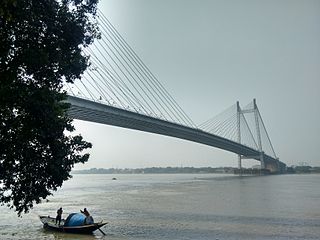
Howrah railway station is a railway station located in the city of Howrah, West Bengal at Kolkata metropolitan region,India. It is the largest and busiest railway complex in India, as well as one of the busiest and largest train stations in the world. It is also the oldest surviving railway complex in India. Howrah is one of the five large intercity railway stations serving the Kolkata metropolitan area, the others being Sealdah, Santragachi, Shalimar and Kolkata railway station.

The Kolkata Metro is a rapid transit system serving the city of Kolkata and the Kolkata Metropolitan Region in West Bengal, India. Opened in 1984, it was the first operational rapid transit system in India. Currently it is the second busiest and fifth longest rapid transit system in India. As of now, it has one fully operational, and three partly operational lines for a total of 59.38 km (36.90 mi). Two other lines are in various phases of construction and planning. The system has a mix of underground, at-grade, and elevated stations using both broad-gauge and standard-gauge tracks. It operates on a 750 V DC Third rail system. Trains operate between 06:50 and 22:40 IST and the fares range from ₹5 to ₹50.

Kolkata the Capital of the Indian state of West Bengal has a good transportation system. Kolkata's transport system is diverse, with a mix of modern and traditional modes of transport catering to the city's large population.

Calcutta Tramways Company (CTC) was a state-run company that operated trams and buses in and around Kolkata in West Bengal, India. The Kolkata tram is the only operating tramway in India and is the oldest electric tram in India, operating since 1902.

Dharmatala is a neighbourhood of Central Kolkata, in Kolkata district in the Indian state of West Bengal. Dharmatala Street has been renamed after Lenin as Lenin Sarani but the neighbourhood up to Wellington Square continues to be referred as Dharmatala. It is a busy commercial area that had come up with the growth of Calcutta during the British Raj and is thus one of the repositories of history in the city.

Kadamtala is a neighbourhood in Howrah of Howrah district in the Indian state of West Bengal. It is a part of the area covered by Kolkata Metropolitan Development Authority (KMDA). Kadamtala is under the jurisdiction of Bantra Police Station of Howrah City Police.

Joka is a locality in South Kolkata, West Bengal, India. It is a part of greater Behala region. This place is mostly known for Indian Institute of Management Calcutta and ESIC Medical College and Hospital.

Bepin Behari Ganguly Street, or B.B. Ganguly Street, formerly known as Bow Bazar Street or Bowbazar Street, is an east-west road in Central Kolkata, capital of the Indian state of West Bengal. It passes through Bowbazar area and connects Baithakkhana Market (Sealdah) and Sealdah Station with Bentinck Street/Rabindra Sarani crossing (Lalbazar) via Amherst Street crossing, Nirmal Chandra Street/College Street crossing and Central Avenue crossing. West of Bentinck Street crossing, B.B. Ganguly Street becomes Lalbazar Street. This road's name is a tribute for Bepin Behari Ganguly, a famous freedom-fighter and politician of India.

Kolkata Metro Rail Corporation (KMRC) is a Government of India enterprise formed in 2008. The agency was formed to oversee the implementing Kolkata Metro Line 2, also known as East West Metro, connecting the twin cities Kolkata and Howrah. The metro rail route is partly underground including the part that will be under the river Ganges. The 16.6 km route has six station each in underground and elevated portions. The terminal stations are Salt Lake Sector V and the Howrah Maidan. The elevated stretch started operations on 13 February 2020.

Netaji is an elevated metro station on the North-South corridor of the Blue Line of Kolkata Metro in Kolkata, West Bengal, India. This station is situated opposite to the Kudghat bus stand at Kudghat, in Tollygunge. This station is named after the freedom fighter Netaji Subhas Chandra Bose.

Esplanade is an underground interchange metro station on the north–south corridor of the Blue Line and on the east–west corridor of the Green Line of Kolkata Metro in Kolkata, West Bengal, India. This station, which is the biggest in the city, is located in the Esplanade neighbourhood of Kolkata, at the northern end of Chowringhee Road/Jawaharlal Nehru Road near New Market and the Oberoi Grand hotel. It opened in 1984 as part of what is now Kolkata Metro Line 1. The station is re-designed to be the largest station of the metro and will function as the interchange station between Line 1, Line 2 and Line 3. The Line-2 complex, built below the Line-1 complex was completed and inaugurated on 6 March 2024. The Line-2 complex is designed with world class amenities and murals that depict the culture, tradition, sports, monuments, important structures, etc. in them.

The Kolkata Tram System, is a tram system that serves Kolkata, the capital city of the Indian state of West Bengal, operated by West Bengal Transport Corporation (WBTC) after Calcutta Tramways Company (CTC) was merged with WBTC. Being started in 1873 Kolkata tram is the second oldest operating tram network in the world after Turin (1871). Being electrified in 1902, Calcutta became the first Asian City with electric tramway. The Kolkata Tram is the only tram system operating now in India. With the help of periodic negligence, the Government of West Bengal had formed systematic initiatives to suspend the entire tram network from the city and sell properties. However, an apolitical organization named Calcutta Tram Users Association (CTUA) was formed in 2016 to advocate in favor of Kolkata's tram system. The network initially had up to 37 lines in the 1960s, but has gradually reduced over the years with only two lines currently operating due to financial struggles, poor maintenance, low ridership, addition of road flyovers, expansion of the Kolkata Metro, slow tram speed and perceptions that the trams are outdated and occupy too much road space. There are currently two tram routes running which are route 5 and route 25.

Line 3 is a rapid transit metro line of the Kolkata Metro in Kolkata, West Bengal, India. A 6.5 kilometres (4.0 mi) stretch from Joka to Taratala of this line was inaugurated on 30 December 2022 and after extended to Majerhat on 6 March 2024. This line will span 16.67 kilometres (10.36 mi) from Joka in the south to Esplanade in the north. It will connect Blue Line at Park Street in central Kolkata and run in parallel with Blue Line up to Esplanade where it will connect with Green Line also. Line 3 is being built by Rail Vikas Nigam Limited.

Line 6(Orange Line) is a rapid transit metro line of the Kolkata Metro in Kolkata, West Bengal, India. It will connect New Garia with Netaji Subhas Chandra Bose International Airport via two major satellite towns of Kolkata metropolitan region, Salt Lake and New Town. It currently operates between Kavi Subhash and Hemanta Mukhopadhyay. This line will be one of the most important stretches of Kolkata Metro because it will connect the southern and the eastern parts of the city with Kolkata Airport. The total distance of this route will be 29.87 km (18.56 mi). It connects Line 1 at Kavi Subhash and will eventually connect Line 2 at Sector-V and Kaikhali and Line 4 at Airport.
Mahakaran, is a metro station on Line 2 of Kolkata Metro, located in B.B.D. Bagh. There are many British heritage buildings near the station with the Lal Dighi adjoining it. The tracks leaving the station towards Howrah go underneath the Hooghly river through the biggest underwater metro tunnel of India. The station was completed and opened on 6 March 2024. The station, though comparing without platform screen doors, may look similar to any Line-1 underground station, but it is actually very different as it is designed with world class facilities and murals that pay tribute to the locality and Indian freedom fighters. The nearest railway station is B.B.D. Bagh railway station. Just before the tunnel enters the underwater segment, lies a ventilation shaft on the Kolkata bank of Hooghly River, which is the deepest of its kind in India, at 44 metres (144 ft) below ground level.

Howrah metro station is a metro station of Kolkata Metro Line 2 in Howrah, India. Built underneath Howrah railway station's new and old complex, the metro station allows interchanging with other zones of Indian Railways as part of the Howrah station transport hub. It is the deepest metro station in India. To the east, the station connects to Mahakaran station in Kolkata through India's biggest under-river metro tunnel beneath the Hooghly river; whilst to the west the adjacent station is Howrah Maidan.
East West Metro Tunnel is an underwater river tunnel of Kolkata Metro in Kolkata, West Bengal. The river tunnel is constructed underneath Hooghly River. It is the biggest underwater river tunnel of India, which is made for metro rail service. The East West Metro Tunnel length is 10.8 km (6.7 mi) and width is 5.5 metres. A 520 m stretch of the tracks goes through a tunnel under the Hooghly River. The roof of the tunnel is about 30 metres from the ground level. The tunnel was completed in 2021. The tunnel is used by East West Metro Line for metro rail service by Kolkata Metro Rail Corporation and it was constructed by Afcons Infrastructure.

Majerhat metro station is an operational metro station on Line 3 of Kolkata Metro. It is the terminal station of the first phase 1 of this line and the first and only station built over an existing railway network, from Joka to Majerhat. The line was sanctioned in India's railway budget of 2010–11, but due to various hurdles, construction was delayed and missed multiple deadlines. The most notable reason for delays was the Majerhat Bridge collapse in 2018.

Dum Dum Park is a locality in South Dumdum of North 24 Parganas district in the Indian state of West Bengal. It is a part of the area covered by Kolkata Metropolitan Development Authority (KMDA).





































